WMS¶
The Web Map Service (WMS) page supports the configuration of raster rendering and SVG options.
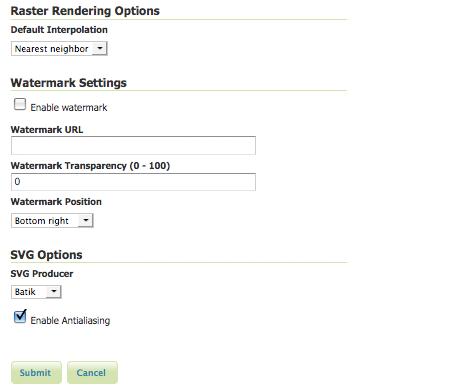
WMS configuration options
Service Metadata¶
See the section on Service Metadata.
Raster Rendering Options¶
The Web Map Service Interface Standard (WMS) provides a simple way to request and serve geo-registered map images. During pan and zoom operations, WMS requests generate map images through a variety of raster rendering processes. Such image manipulation is generally called resampling, interpolation, or down-sampling. GeoServer supports three resampling methods that determine how cell values of a raster are outputted. These sampling methods—Nearest Neighbor, Bilinear Interpolation and Bicubic—are available on the Default Interpolation menu.
Nearest Neighbor—Uses the center of nearest input cell to determine the value of the output cell. Original values are retained and no new averages are created. Because image values stay exactly the same, rendering is fast but possibly pixelated from sharp edge detail. Nearest neighbor interpolation is recommended for categorical data such as land use classification.
Bilinear—Determines the value of the output cell based by sampling the value of the four nearest cells by linear weighting. The closer an input cell, the higher its influence of on the output cell value. Since output values may differ from nearest input, bilinear interpolation is recommended for continuous data like elevation and raw slope values. Bilinear interpolation takes about five times as long as nearest neighbor interpolation.
Bicubic—Looks at the sixteen nearest cells and fits a smooth curve through the points to find the output value. Bicubic interpolation may both change the input value as well as place the output value outside of the range of input values. Bicubic interpolation is recommended for smoothing continuous data, but this incurs a processing performance overhead.
Watermark Settings¶
Watermarking is the process of embedding an image into a map. Watermarks are usually used for branding, copyright, and security measures. Watermarks are configured in the WMS watermarks setting section.
Enable Watermark—Turns on watermarking. When selected, all maps will render with the same watermark. It is not currently possible to specify watermarking on a per-layer or per-feature basis.
Watermark URL—Location of the graphic for the watermark. The graphic can be referenced as an absolute path (e.g., C:GeoServerwatermark.png), a relative one inside GeoServer’s data directory (e.g., watermark.png), or a URL (e.g., http://www.example.com/images/watermark.png).
Each of these methods have their own advantages and disadvantages. When using an absolute or relative link, GeoServer keeps a cached copy of the graphic in memory, and won’t continually link to the original file. This means that if the original file is subsequently deleted, GeoServer won’t register it missing until the watermark settings are edited. Using a URL might seem more convenient, but it is more I/O intensive. GeoServer will load the watermark image for every WMS request. Also, should the URL cease to be valid, the layer will not properly display.
Watermark Transparency–Determines the opacity level of the watermark. Numbers range between 0 (opaque) and 100 (fully invisible).
Watermark Position—Specifies the position of the watermark relative to the WMS request. The nine options indicate which side and corner to place the graphic (top-left, top-center, top-right, etc). The default watermark position is bottom-right. Note that the watermark will always be displayed flush with the boundary. If extra space is required, the graphic itself needs to change.
Because each WMS request renders the watermark, a single tiled map positions one watermark relative to the view window while a tiled map positions the watermark for each tile. The only layer specific aspect of watermarking occurs because a single tile map is one WMS request, whereas a tiled map contains many WMS requests. (The latter watermark display resembles Google Maps faint copyright notice in their Satellite imagery.) The following three examples demonstrate watermark position, transparency and tiling display, respectively.
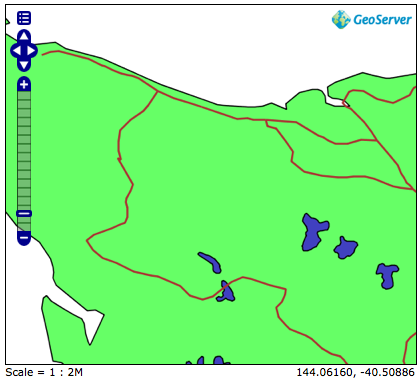
Single tile watermark (aligned top-right, transparency=0)
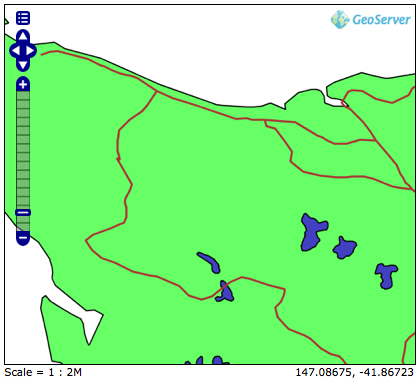
Single tile watermark (aligned top-right, transparency=90)
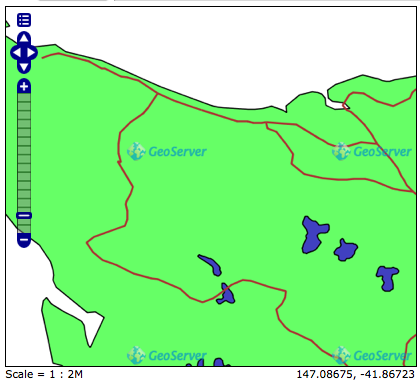
Tiled watermark (aligned top-right, transparency=90)
SVG Options¶
The GeoServer WMS supports SVG (Scalable Vector Graphics) as an output format. GeoServer currently supports two SVG renderers, available from the SVG producer menu.
- Simple—Simple SVG renderer. It has limited support for SLD styling, but is very fast.
- Batik—Batik renderer (as it uses the Batik SVG Framework). It has full support for SLD styling, but is slower.
Enable Anti-aliasing Anti-aliasing is a technique for making edges appear smoother by filling in the edges of an object with pixels that are between the object’s color and the background color. Anti-aliasing creates the illusion of smoother lines and smoother selections. Turning on anti-aliasing will generally make maps look nicer, but will increase the size of the images, and will take longer to return. If you are overlaying the anti-aliased map on top of others, beware of using transparencies as the anti-aliasing process mixes with the colors behind and can create a “halo” effect.
Advanced projection handling and map wrapping¶
Advanced projection handling is a set of extra “smarts” applied while rendering that help getting a good looking map despite the data touching or crossing “difficult areas” in selected map projection. This includes, among others:
- Cutting the geometries so that they fit within the area of mathematical stability of the projection math, e.g., it will cut any bit at more than 45 degrees west and east from the central meridian of a transverse mercator projection, or beyond 85 degrees north or south in a mercator projection
- Make sure both “ends” of the world get queried for data when a map in polar stereographic is hitting an area that includes the dateline
Along with advanced projection handling there is the possibility of creating a continuous map across the dateline, wrapping the data on the other side of the longitude range, to get a continuous map. This is called continous map wrapping, and it’s enabled in Mercator and Equirectangular (plate carrée) projections.
Both functionality is rather useful, and enabled by default, but the tendency to generate multiple or-ed bounding boxes (to query both sides of the dateline) can cause extreme slowness in certain databases (e.g. Oracle), and some might simply not like the wrapping output, thus, it’s possible to disable them both in the WMS UI:
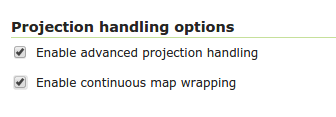
Restricting MIME types for GetMap and GetFeatureInfo requests¶
GeoServer supports restricting formats for WMS GetMap and WMS GetFeatureInfo requests. The default is to allow all MIME types for both kinds of request.

The following figure shows an example for MIME type restriction. The MIME types image/png and text/html;subtype=openlayers are allowed for GetMap requests, the MIME types text/html and text/plain are allowed for GetFeatureInfo requests. A GetMap/GetFeatureInfo request with a MIME type not allowed will result in a service exception reporting the error.
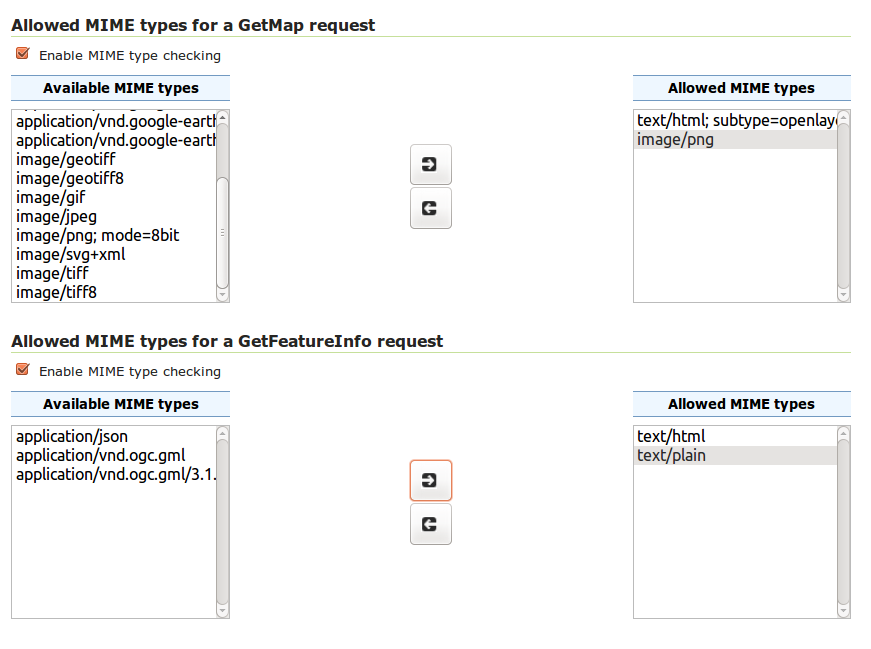
Note
Activating MIME type restriction and not allowing at least one MIME type disables the particular request.